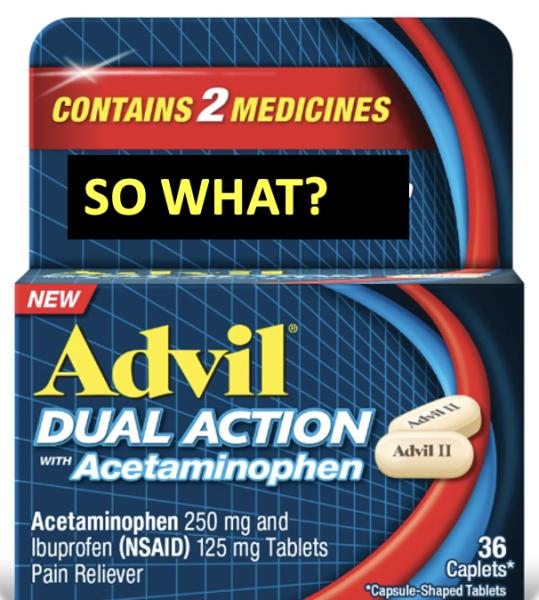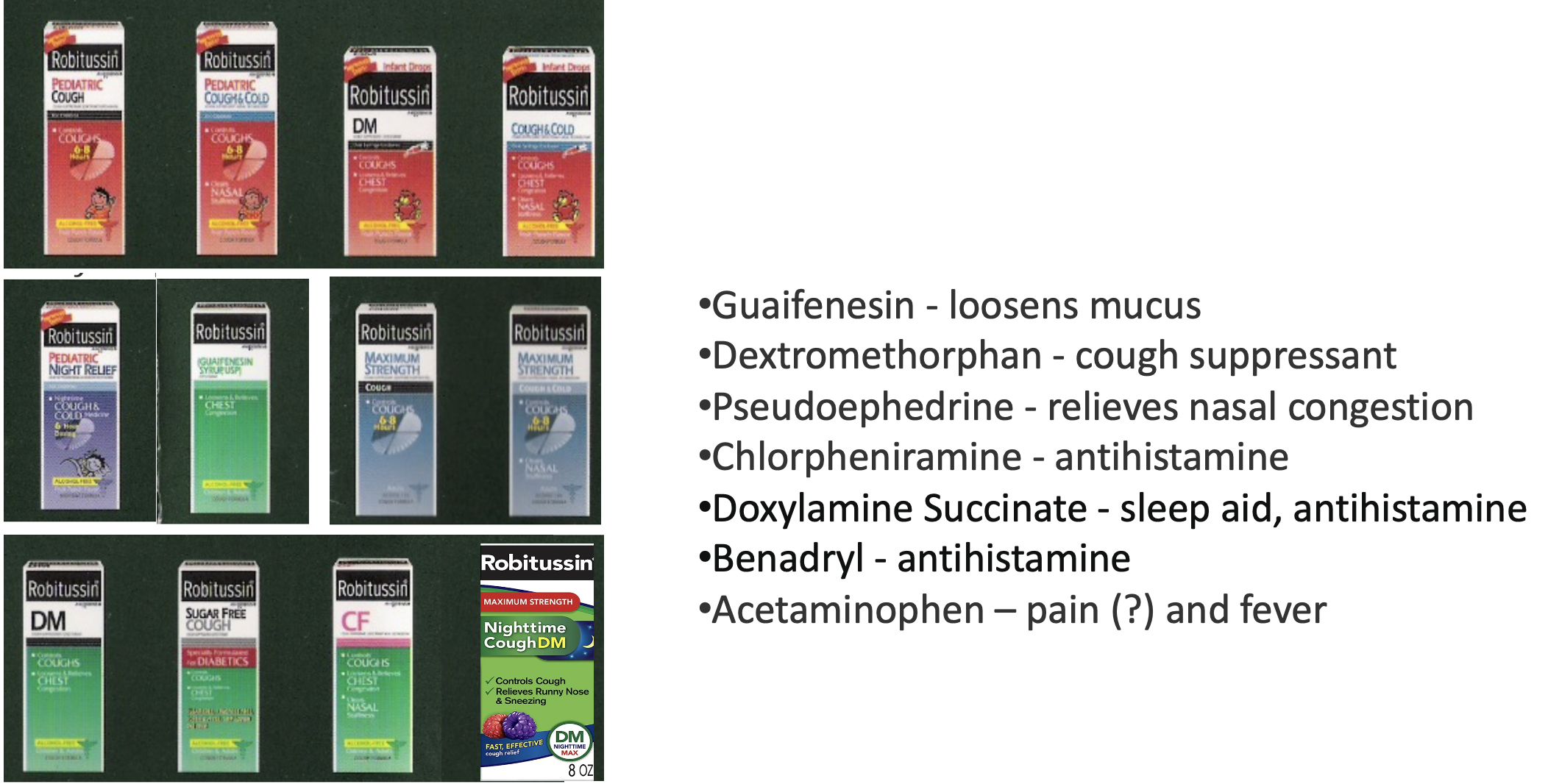
In the past, I've come down pretty hard on the sleazy tactics used by certain pharmaceutical companies to sell more of their over-the-counter products. While there is nothing wrong with companies trying to make more money per se, the tactics used – combining multiple OTC drugs into a single pill or syrup – helps no one except the company. The problem is that when you need, let's say, a cough syrup, you'll run into something like this:

Do we really need 12 different Robitussin products, each a combination of two or more drugs for a cough?
Forgive my cynicism, but the average consumer will have an easier time translating the Rosetta Stone than figuring out which of the seven drugs found in various Robitussin formulations is best for their cough, which may have gone away on its own by the time they have decided what to buy.
There's also the potential for harm. For example, pseudoephedrine (Sudafed) can keep people awake and raise their blood pressure. And it's a decongestant (for a stuffy nose). How many of you cough through your nose? Doxylamine is the generic name for Unisom – a sleep aid and antihistamine, which could presumably be used (don't!) to counteract the side effects of the pseudoephedrine that is treating your "nose cough" and keeping you awake.
Benadryl is not a good drug for young kids and can have a paradoxical effect of keeping them awake rather than how the drug works for adults – an antihistamine sleep aid.
In general, children are more sensitive to the effects of antihistamines. Also, nightmares or unusual excitement, nervousness, restlessness, or irritability may be more likely to occur in children.
And why put acetaminophen into a cough syrup? It does nothing for a cough, and overdoses of the drug are responsible for more than 50,000 emergency department visits per year.
Fifty percent of these [acetaminophen overdoses] are unintentional... More than 60 million Americans consume acetaminophen on a weekly basis, and many are unaware that it is contained in combined products.
This is perhaps the most serious consequence of mixing a bunch of drugs in a pill or syrup under one brand name. Here's a plausible example:
People who are taking Tylenol/acetaminophen for pain, fever, or flu may unknowingly be taking another product, for example, Robitussin Maximum Strength Severe Multi-Symptom Cough Cold + Flu, which contains, among other drugs, 650 mg of acetaminophen per dose. Since acetaminophen is largely ineffective for aches and pains, it's not at all unlikely that some people who have flu will unknowingly be taking this particular Robitussin product and Tylenol simultaneously.
Let's do some math. The instructions on the label of Robitussin Maximum Strength Severe Multi-Symptom Cough Cold + Flu are "take 20 mL (contains 650 mg of acetaminophen) every four hours". In one day, this adds up to 3,900 mg of acetaminophen, which is already higher than the FDA-recommended daily dose of 3,000 mg, down from 4,000 mg before 2009.
The label for Extra Strength Tylenol reads, "Not to exceed 6 caplets in 24 hours, unless directed by a doctor. Total labeled daily dose: 3000 mg/day." Someone who is unwittingly taking both the cough syrup and the pills at the recommended dose will have consumed 6,900 mg of acetaminophen in one day – more than twice the recommended dose and very close to a toxic dose: [my emphasis]
Minimum toxic doses of acetaminophen for a single ingestion, posing significant risk of severe hepatotoxicity, are as follows: Adults: 7.5-10 g
Medscape, 2021
Admittedly, people are unlikely to accidentally take a full day's dose of acetaminophen pills plus Robitussin flu syrup in one sitting; taking a daily total of 6,000 mg of acetaminophen during two consecutive days is also considered to be a toxic dose.
Advil and Tylenol Together. Why?
In 2020, Glaxo-SmithKline received FDA approval to sell Advil Dual Action, a combination of ibuprofen and acetaminophen in one pill containing 125 mg of ibuprofen (1) and 250 mg of acetaminophen. The directions tell you to take two caplets every eight hours (no more than six per day), making the combined daily dose 750 mg of ibuprofen and 1,500 mg of acetaminophen. In a press release, GSK writes: [my emphasis]
The submission in support of today’s approval of Advil Dual Action was based on data from seven clinical studies, three of which were pivotal efficacy and safety studies in pain relief. The data supports a pain relief indication and demonstrates that the fixed-dose combination achieves superior efficacy compared to the individual monocomponents of ibuprofen (250mg) and acetaminophen (500mg) alone (as evidenced by appreciable improvements in acute pain symptoms across multiple pre-specified endpoints).
Sleaze alert!
GSK probably doesn't want you to read or understand the paragraph above. Why? Because the company isn't comparing the efficacy of Advil Dual Action to a combination of ibuprofen and acetaminophen pills taken together. The key word here is "alone." When taken together, there is good evidence that the two drugs work better than either alone.
Ibuprofen plus paracetamol combinations provided better analgesia than either drug alone (at the same dose), with a smaller chance of needing additional analgesia over about eight hours, and with a smaller chance of experiencing an adverse event.
Derry, et. al, Cochrane Library 24 June 20 https://doi.org/10.1002/14651858.CD010210.pub2
However, the company does not compare the combination of the two drugs to its product; it just compares its product to both alone. Will the same doses of the two separate pills together work as well? Bet the house on it.
What's the downside?
1) Double the price: CVS sells a bottle of 72 Advil Dual Action capsules for $0.19 per pill (72 pills, 36 doses, $0.38 per dose). The store also sells a bottle of 200 mg ibuprofen pills (50 pills, 50 doses, $0.14 per dose) (4) and generic extra-strength acetaminophen (100 pills, 100 doses, $0.08 per dose). The Advil Dual Action costs almost twice as much per dose as the generic ibuprofen and acetaminophen purchased separately ($0.22).
2) Acetaminophen overdose
This is less likely to happen than when Advil Dual Action and acetaminophen are mistakenly taken together. Why? The maximum recommended daily acetaminophen dose in Advil Dual Action is 1,500 mg (compared to 3,900 mg in the Robitussin Maximum Strength Severe Multi-Symptom Cough Cold + Flu syrup). Even if someone inadvertently takes the maximum daily dose of 3,000 mg of acetaminophen together with Advil Dual Action, they will get a dose of only 4,500 mg, which is very unlikely to be harmful.
3) Lack of dose "titration"
This is a fancy way of saying that when taking Advil Dual Action, the patient is unable to "tweak" the amounts of the two drugs to best suit their needs. Dr. Henry Miller explains: [my emphasis]
Titrating means adjusting the dose of something to obtain the desired result. Examples include a certain pH level (degree of acidity) in a solution; the amount of white paint mixed into a color to get the "right" shade; or, in the case of drugs, the right dose to get relief from a certain sign (like high blood pressure) or symptom (like pain). However, for a drug that has multiple ingredients, the prescriber and patient don't get to vary the ingredients independently to get to the desired result. For example, Alka Seltzer Plus Severe Cold and Flu contains four drugs -- a pain/fever reducer, a nasal decongestant, an antihistamine, and a cough suppressant. The disadvantage is that a patient may not tolerate the fixed dose of one or more of the ingredients well, but is unable to vary the dosages.
And Dr. Chuck Dinerstein adds:
Each drug has its own therapeutic window and if they are sufficiently different then the drug with the smaller window controls the maximum dosage, another example of the inflexibility introduced by fixed combinations.
Bottom line
Given the ever-dwindling options for pain relief, it is somewhat comforting that two common, but imperfect, drugs given together in lower doses can be more effective and less prone to dangerous side effects than either alone. But there is little or no advantage, except perhaps for GSK, to sell pills with fixed ingredients, as Drs. Miller and Dinerstein pointed out. I would not be the least bit surprised if the sale of the two-component pill was driven by commercial rather than medical needs. It's been done before and surely will be done again.
NOTES:
(1) It is essentially impossible to recreate the GSK formula because the company uses 125 mg of ibuprofen per pill, making a single dose of 250 mg. The drug comes in ibuprofen doses of 200 mg (the most common), 300 mg, 400 mg, 600 mg, and 800 mg. For this article, I assumed that pills containing 250 mg of ibuprofen are roughly equivalent to those containing 200 mg.



